Here’s a beautiful wildlife video of beetles and birds in slow motion.
Slow down and watch.
Happy Friday!
(video from Cornell Lab of Ornithology via YouTube)
Here’s a beautiful wildlife video of beetles and birds in slow motion.
Slow down and watch.
Happy Friday!
(video from Cornell Lab of Ornithology via YouTube)
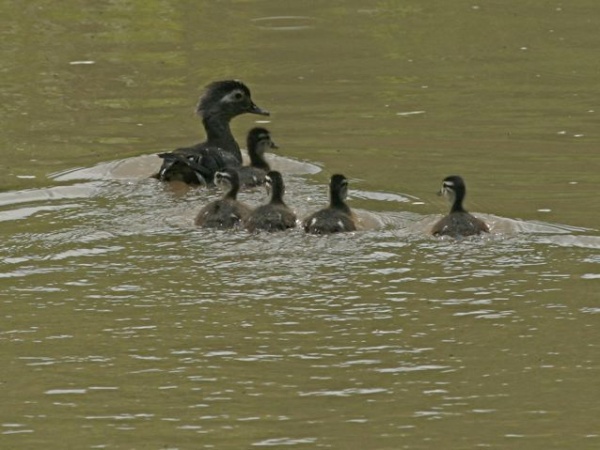
On Throw Back Thursday (TBT), let’s revisit an article on the size of baby birds.
Have you ever seen a tiny baby pigeon walking around with its parents?
No.
Why do we see baby ducks but never baby pigeons? Click here to read why.
(photo of wood duck mother and babies by Chuck Tague)
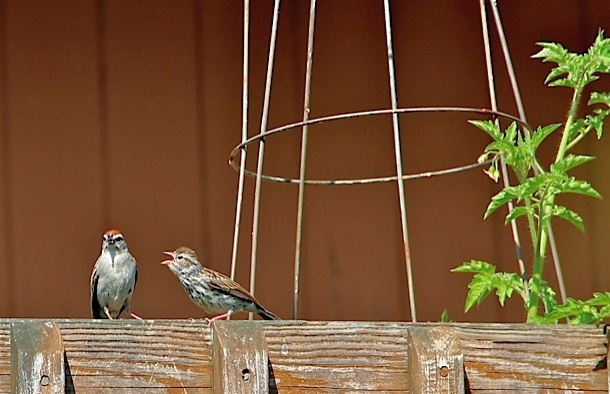
Early July is a great time to watch songbird families. Many baby birds have just fledged and are still dependent on their parents for food … or they would like to be.
Marcy Cunkelman sees the family interactions up close in her birds-and-butterflies garden. Here are some of her family portraits.
Above, we see that fledglings are the same size as their parents but don’t always look like them. You can tell they’re related by their actions as this young chipping sparrow begs for food while his parent leans away from the noise! The juvenile’s stripes provide camouflage but make him resemble a song sparrow more than the pale, plain-chested adult.
Below, a tree swallow feeds her newly fledged baby. Since swallows capture insects on the wing, the juveniles have to fly well enough to catch bugs before they’re able to feed themselves.
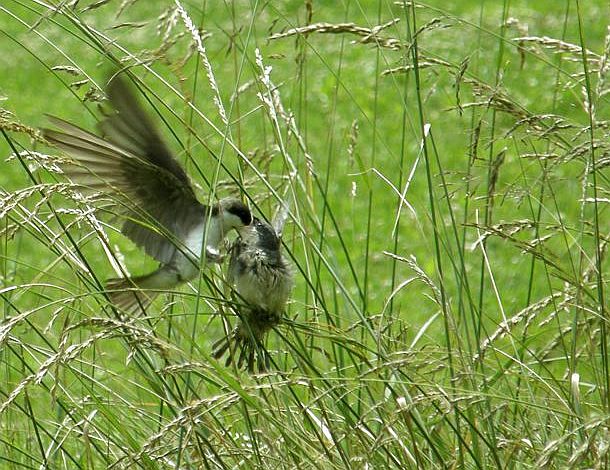
And below, a downy woodpecker offers a seed to his baby. When the babies are young the parents lead them to the feeders and offer them seeds. Pretty soon the juveniles figure out that it’s faster to get the seeds on their own.
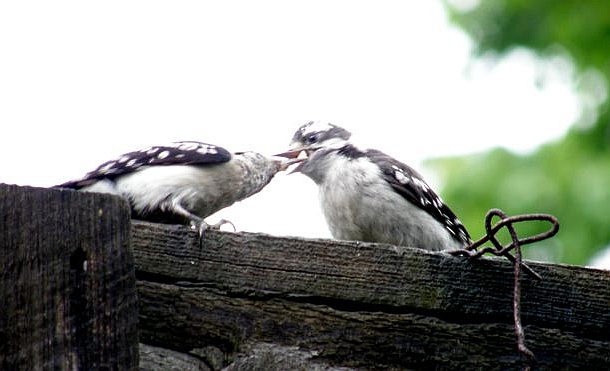
Soon the youngsters will be independent. Meanwhile you’ll see them say, “Feed me!”
p.s. Wissahickon Nature Club will have an outing to Marcy’s garden this coming Saturday, July 12. Click here for details.
(all photos by Marcy Cunkleman)
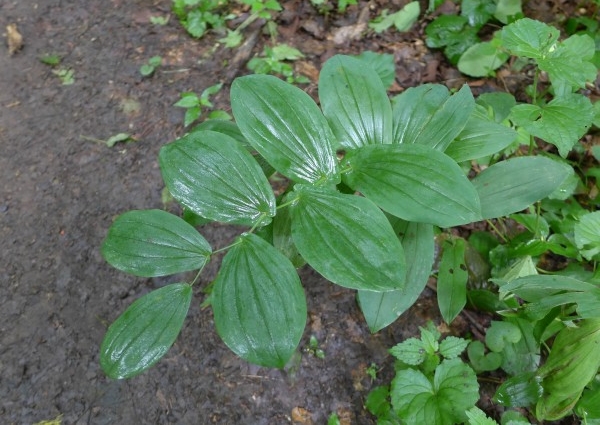
Today we’ll have a plant identification quiz. I have an answer but you may have a better one.
I found this plant on June 29 at Dead Man’s Hollow in Allegheny County. The leaves are so distinctive that its identity begs for some detective work. Here are the clues I gathered:
Leaves:
The plant had no flowers and no buds. Instead it had developing fruits which gave me clues about the flowers. Here are two photos of the fruits.
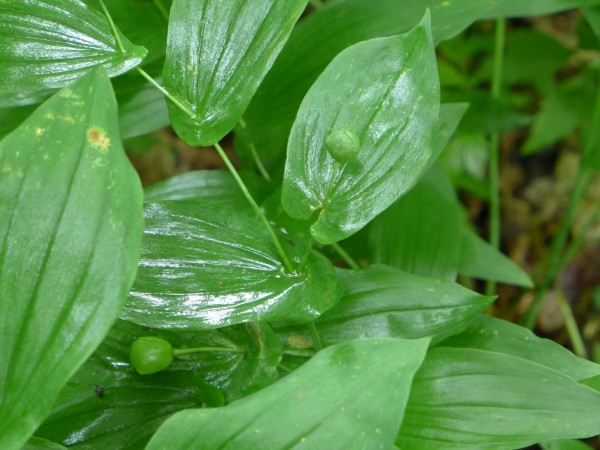
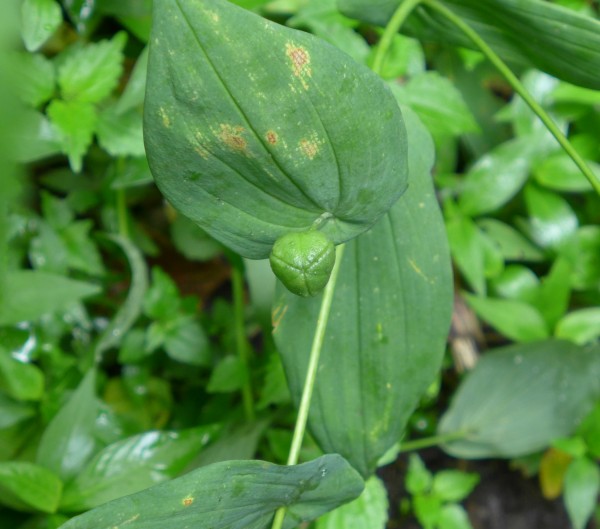
The fruits are:
I looked up “six petals with alternate, entire leaves” in my Newcomb’s Wildflower Guide and found a familiar spring wildflower with perfoliate leaves.
However, I am not completely satisfied with my identification. I have never seen “my plant” arc horizontally like this when it’s blooming and the fruits in the illustration look different. Is my Newcomb’s Guide missing a species? Have I never noticed that the plant “lies down” in the summer? Are the fruits going to match the illustration when they mature in a few weeks?
So here’s the quiz: What plant is this?
Leave a comment with your answer. I’ll post my guess after I’ve heard from you.
UPDATE: It is large-flowered bellwort (Uvularia grandiflora). See the Comments for a link to the flowering version of this plant.
(photos by Kate St. John)
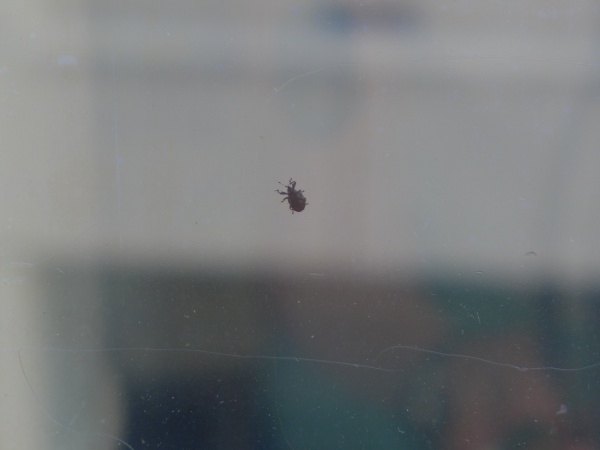
UPDATE: These are actually yellow poplar weevils, not billbugs, but it’s impossible to change the title.
7 July 2014
A week ago these bugs were everywhere, so many that they made the news.
I noticed them on June 30 when I saw more than twenty tiny dark bugs perched on the outside of my office window. What bugs were these, why were there so many of them, and why were they on the window?
Other people encountered the bugs too — at poolsides, on car roofs, in backyards — and they were scared because the bugs looked like engorged ticks.
Though close in size, I can tell these are not ticks because:
Using Google and BugGuide.net I narrowed their identity to some sort of snout and bark weevil. But which one? And why were there so many of them?
Meanwhile public fear and misunderstanding prompted KDKA to call the Allegheny County Health Department’s Entymologist, Bill Todaro for information. He knew what they were right away: Yellow Poplar Weevils. Nut and Acorn Weevils(*). Also called billbugs, They eat only plants, never bite people, and swarm in late June because they’re looking for a member of the opposite sex to mate with.
Here’s an annotated closeup of one of the weevils on my office window. This is a view of his underside because he was outside on the glass.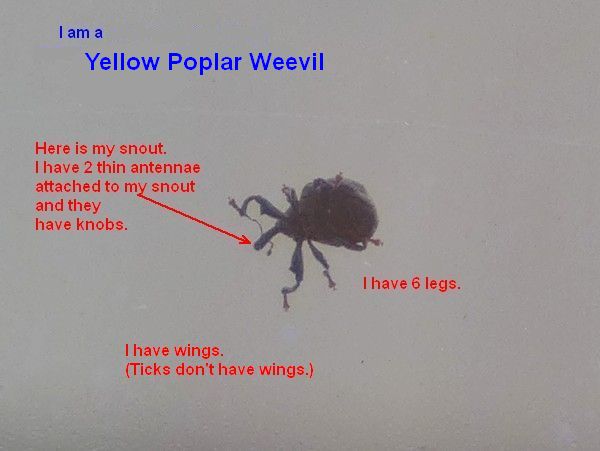
So, they were really nothing to worry about. They were courting. We just never noticed them before.
(photos by Kate St. John)
UPDATE 18 June 2015: Ben Coulter and Monica Miller have identified this weevil as Odontopus calceatus, a.k.a. Yellow Poplar Weevil, not Curculio as I read in the paper last year(*). Don’t believe everything you read in the paper!
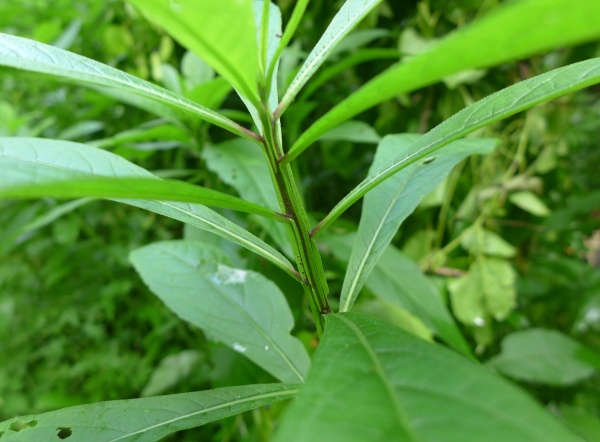
Two months before it blooms we can identify this plant even though it has no flowers. Look at its stem!
Wingstem (Verbesina alternifolia) is already five feet tall and on its way to eight. It will look like this in August. Meanwhile the stem gives away its name.
The “wings” are petiole extensions that run the length of the stem. The newest wings at the top of the plant are straight with a dark margin. The older part of the stem has long white hairs in the margins. Sometimes the wings are wavy.
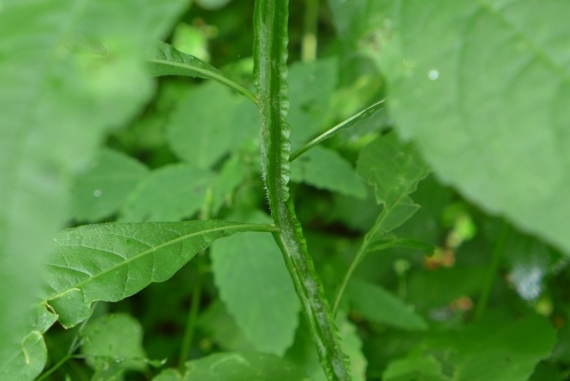
To me the wings look like flanges. “Flange-stem?”
Say that three times quickly and you’ll know why it’s called wingstem!
(photos by Kate St. John)
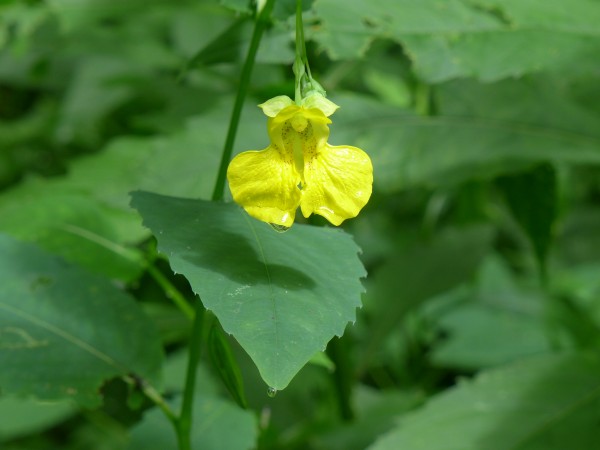
Blooming now in southwestern Pennsylvania, Pale Touch-me-not (Impatiens pallida) beacons to bees with its yellow landing pad.
(photo by Kate St. John)
also called yellow jewelweed
This juvenile bald eagle is only four months old, hatched at the Hays nest in Pittsburgh, PA.
Thanks to Dana Nesiti for his photo from the Eagles of Hays, PA Facebook page.
Happy Fourth!
(photo by Dana Nesiti, Eagles of Hays, PA)
It’s Throw Back Thursday…
Six years ago bald eagles were doing well in Pennsylvania with 140 active nests. Back then we knew it was only a matter of time before they’d be off Pennsylvania’s endangered list but we couldn’t imagine how quickly that would happen.
Who knew that by July 2014 we’d have 250 nests in Pennsylvania, three of them in Allegheny County, and one in Pittsburgh that’s internationally famous because of its webcam!
Click here or on the bald eagles’ photo above to go back in time to July 2008 when there were no eagles to watch at the Three Rivers Heritage Trail and far fewer eaglecams. At that time one of the famous eaglecams was at Norfolk Botanical Gardens where the pair had a Peyton Place year and an ailing eaglet.
After you read the 2008 Norfolk eagle story, you might be wondering what happened to the eaglet with avian pox. Nicknamed Buddy he lives in captivity because his beak grows in a deformed shape and must be trimmed once a month so he can eat. Though otherwise healthy, he would die in the wild without this treatment. He will never fly free.
(photo by Chuck Tague)
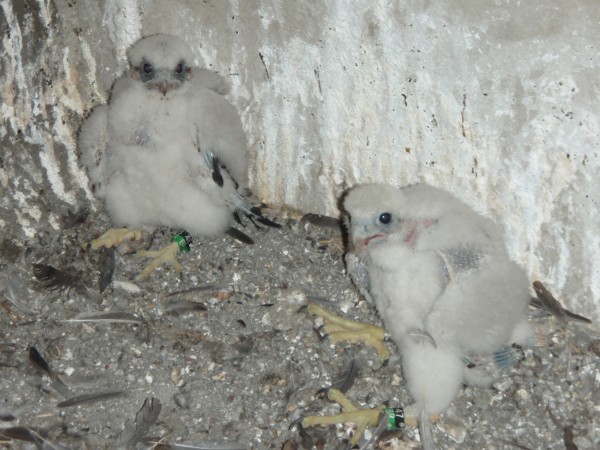
Just when you thought peregrine nesting season was over, there’s one more nest remaining to fledge in Pittsburgh.
Yesterday morning Tom Keller of the PA Game Commission rode with PennDOT in their graciously provided bucket truck to band the nestlings at the Westinghouse Bridge. This late nest was first confirmed on May 20 when Dan Brauning and Tom Keller found the female incubating three eggs. On June 10 Tom confirmed the first hatchling. Yesterday he banded two females. (One egg didn’t hatch.)
This late-in-the-season nest cycle is probably a re-nesting after the first attempt failed. Nest failures at natural cliff sites can be caused by predation but this location is so inaccessible that the re-nest is probably due to a changeover in adults after a peregrine-vs-peregrine challenge. The banded female, Hecla, hatched in 2009 at the Ironton-Russleton Bridge in Ironton, Ohio and has been present at Westinghouse since 2012. Perhaps her banded mate is new but no one has been able to read his bands. He’s still unidentified.
Westinghouse site monitor (and proud “papa”), John English, organized a Banding Watch under the bridge. Thanks to photos from watchers Maury Burgwin and Donna Memon, I’ll tell the rest of the story in pictures.
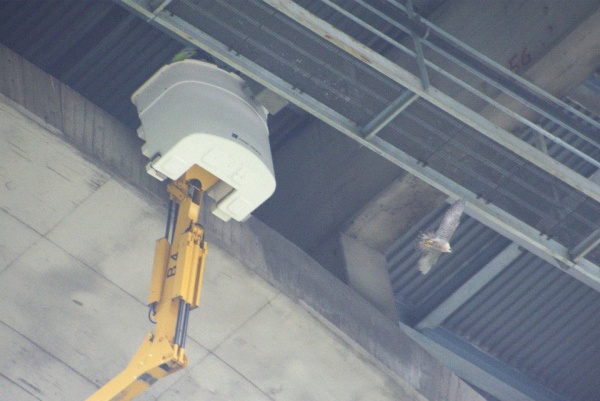
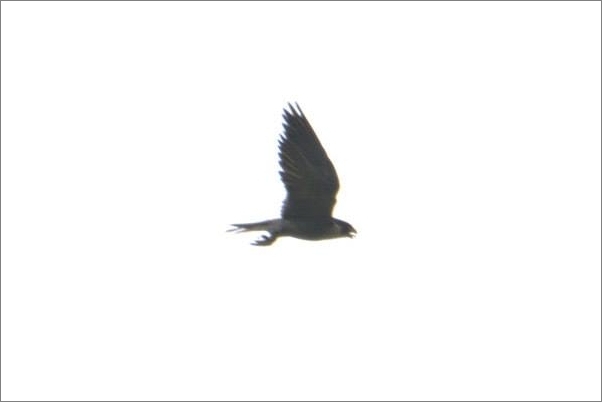
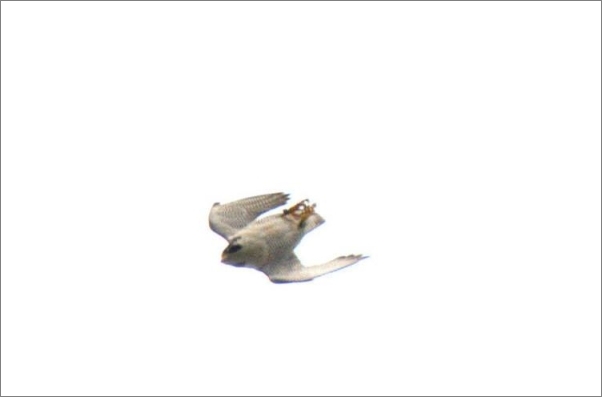
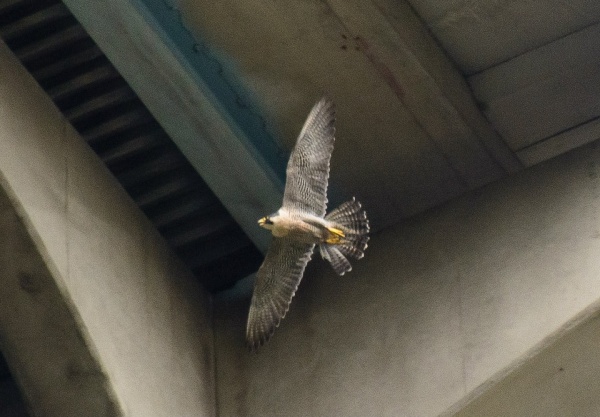
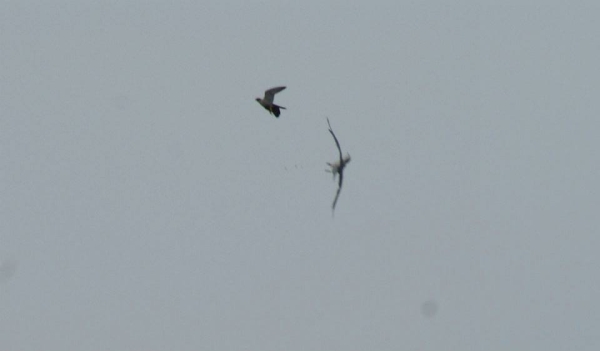
Stay tuned for Fledge Watch, July 18, 19 and 20! Check Pittsburgh Falconuts for details.
(photo credits:
Nestlings by Thomas Keller, PA Game Commission.
Action shots of adult peregrines by Maury Burgwin.
Peregrine-vs-gull encounter by Donna Memon)